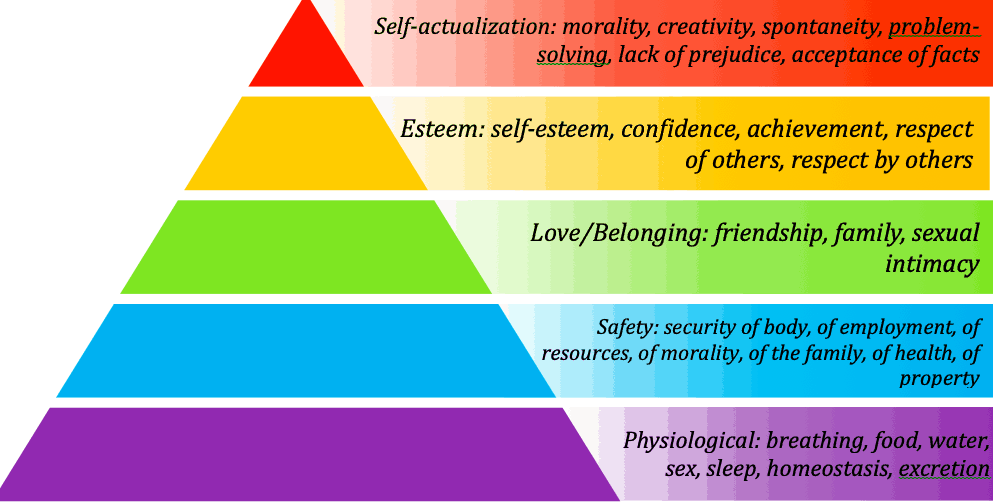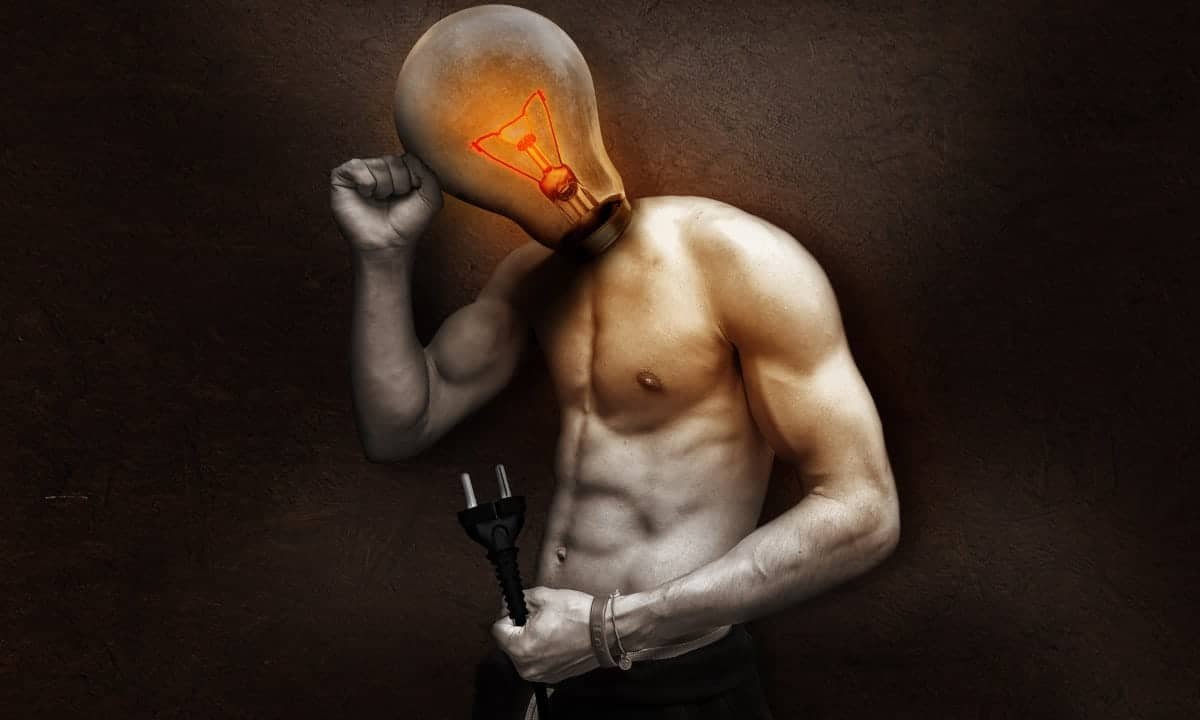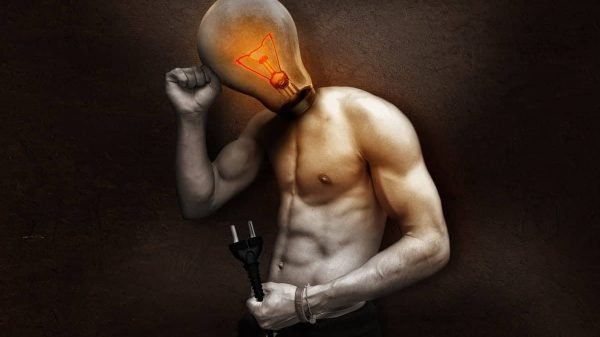A definitive guide to self-actualization based on Maslow’s Hierarchy of Needs, including examples, 6 key steps to accelerate growth, and questions and answers.
It is considered the pinnacle of human needs and the ideal we all strive for, but what is it? In this article, we look at the definition of self-actualization as it stands today, highlight the importance of self-actualization for the average person, and provide several self-actualization examples for clarity.
We also answer a series of commonly asked questions about self-actualization so that you walk away from this article having everything you need to take immediate action towards reaching your full potential.
As you will find, self-actualization is an integral part of the TooManly lifestyle and tantamount to being a primed man.
IN THIS GUIDE
Self-Actualization Definition
What is self-actualization? That is one question every man should ask at least once in his lifetime. And the sooner you become acquainted with the concept, the better.
The term was first coined by German organismic theorist Kurt Goldstein but the theory itself was brought to prominence in Abraham Maslow’s hierarchy of needs.
When Maslow first outlined his theory of basic human needs, he described self-actualization by stating “what a man can be, he must be. This need we may call self-actualization.”
What Maslow is essentially describing is the growth an individual undergoes towards the fulfillment of his highest needs, having the freedom and liberty to tackle those most advanced concepts and “big questions” humans struggle with, such as the meaning of life.
Search ‘self-actualization definition’ in google and you’ll get results from Merriam-Webster, New Oxford American Dictionary, and disctionary.com all stating something along the lines of ‘the psychological process aimed at maximizing the use of a person’s abilities and resources’.
The New Oxford American Dictionary, in particular, defines self-actualization as “the realization or fulfillment of one’s talents and potentialities, especially considered as a drive or need present in everyone.”
No matter how you define the concept, self-actualization ultimately boils down to the full realization of your creative, intellectual, social potential, or even physical potential.
Theory Of Self-Actualization And The Hierarchy Of Needs

Maslow hierarchy of needs maps out the entirety of human existence, highlighting the basic needs that all people share.
A good starting point for understating self-actualization is contextualizing it within Maslow’s Hierarchy of Need, which groups a person’s needs into five categories spaced across a bottom-to top-pyramid.
They are as follows, arranged from top to bottom:
- Self-actualization needs: (self-growth, fulfillment of one’s potential, purpose, and meaning in life)
- Esteem needs: (self-respect and respect from others, positive feelings about yourself derived from achievement, reputation, and admiration)
- Belonging and love needs (Intimate, caring relationships with family, friends, and colleagues; affiliation with a group)
- Safety needs (shelter, clothes, protection, routine and predictability, freedom from fear and anxiety)
- Physiological needs ( food, water, sleep, air)
At the bottom of the pyramid are our physiological needs, followed by our safety needs at the second level, love needs at the third level, and esteem needs at level four.
“Self-actualization” marks the tip of the pyramid, representing the pinnacle of all human needs.
Growth Needs Versus Basic Needs

Once we satisfy our basic needs like sustenance, security, and sense of belonging, we can dedicate more of our energy to the growth needs required for self-actualization.
According to the theory, each level of needs must be taken care of before the next one can be addressed. And Maslow made a distinction between people driven by growth needs and those motivated by deficiency (basic) needs.
Essentially, every need below self-actualization is a basic need of deficiency and selfish taking instead of giving. And when they aren’t being met, something feels missing, causing us to experience tension that can lead to neurotic behavior.
For example, without food and water for sustenance (physiological needs), you won’t have the energy to obtain shelter, let alone defend yourself from potential dangers (safety needs). And you’re definitely not going to be too concerned with what people think of you (esteem needs).
So until we fulfill our basic needs, our energy and attention is focused on gratifying them. But once gratified, we can dedicate a lot more of our attention to growth needs.
Whereas basic needs are external, growth needs are internal. Self-actualization encapsulates the drive to fulfill our growth needs.
When our growth needs are met, we are no longer motivated by what other people think and are instead driven by something deeper within. We are concerned with our creative self-growth, engendered from fulfillment of our potential and purpose.
Self-Actualization Examples
All of us want to achieve a level of self-mastery that reflects our true potential, but what does self-actualization actually looks like?
“A musician must make music, an artist must paint, a poet must write, if he is to be ultimately happy” – Abraham Maslow.
Maslow came up with the concept of self-actualization after studying the works, habits, daily practices, attitudes, and beliefs of people he believed were self-actualized.
Here are few notable individuals he considered to be ideal self-actualization examples.
- Abraham Lincoln: American statesman and lawyer who served as the 16th president of the United States from 1861 until his assassination in April 1865.
- Thomas Jefferson: American statesman, diplomat, lawyer, architect, and Founding Father who served as the third president of the United States from 1801 to 1809.
- Albert Einstein: Theoretical physicist who developed the theory of relativity, one of the two pillars of modern physics.
- Baruch Spinoza: Considered one of the great rationalists of 17th-century philosophy, and an early thinker of the Enlightenment and modern biblical criticism, including modern conceptions of the self and the universe.
Other examples of people believed to be fully self-actualized individuals include anti-apartheid activist and former South African president Nelson Mandela, anti-colonial nationalist Mahatma Gandhi, and Roman emperor and Stoic philosopher Marcus Aurelius.
Although these self-actualization examples were all public figures, it is interesting to note just how different they are from one another. You have politicians, authors, physicists, philosophers, poets, and so on.
14 Traits of Self-Actualized People

Self-actualization doesn’t manifest the same way for everyone, but there are key traits that all self-actualizers have in common.
Self-actualization is not a state of being reserved for public figures. Just look around you! Chances are you probably know someone who has self-actualized.
It could be your teacher, your mother, father, or sibling; it could be your best friend or the person you aspire to be.
The self-actualized person in your life can be an unassuming anybody, but Maslow discovered 14 key traits that all of them have in common.
1. Superior perception of reality
Self-actualizing people see the world as it is, rather than distorted by their needs and beliefs. They have the uncanny ability to judge others accurately and detect dishonesty, and this makes them better able to make effective decisions.
2. Increased acceptance of oneself, others, and nature
Self-actualizing people have less overriding guilt, crippling shame, and severe anxiety. They can accept who they truly are, including their strengths and weaknesses, as well as the consequences of their actions, without feeling worried.
3. Increased spontaneity
These people are more spontaneous in their behavior, actions, thoughts, and impulses than the average person. Their lives are marked by a high degree of simplicity, honesty and naturalness.
They can play the social game when necessary to avoid hurting someone’s feelings, but don’t do so otherwise.
4. Increase in problem-centering
They are more focused on problems outside themselves than on personal issues (ego-centered). They are dedicated and committed to their work, and find great satisfaction from it.
They often have missions in life and tasks to fulfill that demand much of their energies.
5. Increased detachment, desire for privacy and independence
These mentally healthy people are comfortable being by themselves and are not emotionally dependent on others. They positively like solitude and privacy to a greater degree than the average person.
6. Increased autonomy, self-sufficiency and resistance to enculturation
Whereas the average person is dependent on and motivated by social or cultural forces, self-actualized people are relatively independent of such external forces, instead focusing on developing their potentialities in pursuit of internal growth.
They are resistant to social pressures about how to think or act, but not rebellious for the sake of rebellion.
7. Greater freshness of appreciation, richness of emotional reaction
They have an ability to appreciate experiences as if they were new, feeling a sense of awe, wonder, and pleasure with the inherent elements of life long after they become stale to others. They tend to be grateful for what they possess and can experience.
8. Experience more ‘peak’ experiences
Peak experiences are transcendent moments of pure joy and elation involving a heightened sense of wonder, awe, or ecstasy. Memories of such ‘mystical’ events are lasting, and people often equate them to a spiritual experience.
Everyone is capable of having peak experiences, but self-actualized individuals tend to experience them more often.
9. Increased identification with the human species
Self-actualizing individuals develop a deep feeling of empathy and affection for all human beings, and this increased sense of kinship leads them to become more humanitarian.
They have evolved from exclusively identifying with themselves (egocentric) or a group (sociocentric) to identify with all of humanity (worldcentric).
10. Maintain stronger, richer interpersonal relationships
A greater capacity for love and a better control of their ego means they have richer relationships. However, many only form deep bonds with a select few individuals, and generally maintain a relatively small circle of friends.
11. More democratic character structure
Self-actualizers are not authoritarian, do not want “power over” others or to be subjugated by others. Identifying more closely with the human species than to themselves, they accept all people regardless of class, education, race, ethnicity, sexual orientation, etc.
Just as important, self-actualizing people readily learn from anyone; can distinguish clearly between means and ends, as well as between right and wrong; and have a clear sense of ethics.
12. Increased creativeness in everyday conduct
Self-actualizing people exhibit an increase in creative expression. They are original, inventive, and innovative in whatever their realm of life may be.
However, this creativeness is not the “special talent” type of creativity that takes years of practice to cultivate. Rather, it is more akin to the innocent, playful, and spontaneous creative expression found in young children.
13. Certain changes in the value system
With their philosophical acceptance of their true nature, as well as human nature and physical reality, these people establish a firm value structure.
An appreciation and acceptance of human nature means many of the so-called “life problems” are seen as gratuitous.
14. Have an unhostile sense of humor
Maslow’s characteristics of self-actualized people might make them seem like Is dull, emotionless, and serious automatons, but they are anything but. Self-actualizers do have a sense of humor, but it’s not of the ordinary type.
They do not find hostile or superiority humor funny, instead preferring humor that is more closely allied to philosophy than anything else. They tend to joke about humanity as a whole and all of its shortcomings.
Problem With The Hierarchy Of Needs

Considered one of history’s most notable self-actualization examples, Nelson Mandela overcame the lack of safety in a volatile socio-economic environment to realize his dream.
According to Maslow, it’s not possible for a person to progress to the level of self-actualization if they don’t fulfill the lower level needs. However, there have been many examples of self-actualized people who have proven otherwise.
These hierarchy-busting individuals have skipped levels, having scrambled up to realize their highest potential without being entirely absorbed by the so-called “fundamental” needs.
Nelson Mandela, for example, is someone most people would agree realized his dream and lived a life of purpose.
In fighting for racial equality and a classless society in an extremely volatile socio-political climate, he was imprisoned for 27 years as a result of his revolutionary activities and deprived of many of his basic needs.
Yet, Mandela emerged a sage — a beacon for change, unity, progress, and even forgiveness.
How about Viktor Frankl? The Austrian psychologist experienced first-hand the horrors of a Nazi concentration camp. Rather than letting his body and mind succumb to the unimaginable suffering, he used the time in confinement as an opportunity to reflect and ponder, emerging entact to chronicle his experiences in his critically-acclaimed book Man’s Search for Meaning.
In the book, Frankl reflects on the concepts of pain and resilience, as well as life and what makes one feel alive. He surmised that man is driven by a quest to find meaning in life, and meaning allows him to overcome the trauma of even the most painful and dehumanized living conditions.
Nelson Mandela and Viktor Frankl are just a few examples of self-actualized individuals who, despite experiencing the most adverse social, physical, and emotional conditions, were able to see past the lack of safety in their circumstances and kept hold of their being values.
They demonstrate that we don’t need to have all our basic needs met before we can pursue self-actualization, though satisfying them frees up more time and energy to be devoted to actualizing our full potential.
Doing The Inner Work To Achieve Self-Actualization
The journey to reaching your full potential begins once you ignite the self-actualization fire within you. To do this, you must do the inner work.
A connection can be made between Maslow’s Hierarchy Of Needs and psychologist Carl Jung’s theory of Individuation, which can be surmised as an organic transformational process that gradually gives rise to self-realization or the highest expression of a person’s potential.
Jung saw self-actualization as a process of personal development that results from the integration of the conscious (awareness of your own thoughts, images, feelings, attitudes, beliefs, responses, and sensations) and the unconscious (the part of your life experience of which you are unaware).
Considering that the self flows from your two inner worlds (conscious and unconscious), self-actualization is a manifestation of the mind.
In other words, external variables such as an expensive car, a nice house, or a hot wife aren’t vital to your self-actualization. And not everyone finds purpose working a 9-5 corporate job, even if it pays well.
The most important thing is your “state of being” and what’s happening in your mind. For some, living a meaningful life might be building homes for impoverished people, working at an animal shelter, or living a nomadic lifestyle.
But while the conscious mind is out in the open, the unconscious mind lies buried deep within us, not easily accessible. So decoding the unconscious is the key to achieving harmony and, ultimately, self-actualization.
Self-Actualization Is A Journey

Self-actualization is a journey, not a destination, so expect delays, detours, losing your way, and changing plans.
Is it possible to be too self-actualized? Very unlikely! And that’s because self-actualization is a journey and not a destination, where upon reaching, you celebrate and become content to sit back.
It is a lifelong adventure full of delays, detours, losing your way, and changing plans. You will trip and fall. You may even think about quitting, reverting back to the comfort and familiarity of your old way of thinking and living. Don’t waver!
The key to staying on course is being resilient, adjusting your mindset while navigating the trials and tribulations you will face, and viewing setbacks and failures as lessons towards a better you.
On your journey to self-actualization, don’t get bogged down by any plans or maps. A fluid mind is a major trait of self-actualized people, so be flexible with your endeavours and embrace the unknown.
Do anything you can to get out of your comfort zone.
How To Know If You Are Self-Actualized
Are you a self-actualizing man? Reviewing the 14 characteristics of self-actualization, can you assess how far along your are in your journey?
It helps to ask yourself questions such as the following:
- Am I more spontaneous than I was ten years ago?
- Am I more self-sufficient and autonomous? Have I found comfort in being alone?
- Do I have a more democratic character structure?
- Have I improved my ability to develop and maintain strong, rich relationships?
- Do I feel at one with the people around me, strangers and alike?
- Am I living a more creative life?
Remember, in Maslow’s view, self-actualization is a state of being that occurs spontaneously as each one of our basic needs is met.
When you feel unsafe (a safety need), unappreciated (a belonging need), or unworthy (an esteem need), your energy and motivations are focused on meeting these needs.
In other words, the drive to pursue such basic needs supersedes everything else, placing you out of your center,
However, when you center yourself in a state of mastery, the feeling of incompleteness disappears, and you can just be.
Don’t forget that you don’t need to meet all your basic needs in order to achieve self-actualization, though doing so can greatly accelerate the process.
How To Achieve Self-Actualization (6 Steps)
Self actualization is a core theme of many of the personal development guides developed for the Too Manly community.
The journey to achieve self-actualization can begin at any age, and children — with their insatiable curiosity and a boundless exploratory spirit — are at a very advantageous starting point.
Unfortunately for most of us (myself included), the curiosity and sense of wonder that comes with childhood wasn’t cultivated in youth. In fact, it may have been unknowingly extinguished by someone, possibly our parents or other loved ones.
It is usually an unbearable sense of dissatisfaction with how we are living and who we have become that spurs many adults to be deliberate with their journey to self actualization.
We begin to realize that there is more to life and that we are capable of a lot more. (Is this realization perhaps what drove you to the Too Manly community?)
Part of doing the inner work and looking behind the veil of your hidden self is to question and reflect on what you see. Blast through the mirrors of reality to discover what truly holds meaning for you.
By doing so, you will begin to realize that there are many ways you can develop your intelligence and numerous gifts to reach your highest potential.
These six steps can help you to accelerate your self-actualization:
———————-
Step 1: Have a personal vision for the man you’re evolving into
It’s difficult, if not impossible, to reach self-actualization if you can’t envision what your actualized self looks like. As such, writing a vision statement should be the first step in focusing your life.
A vision statement will guide your life, providing the direction needed to chart the course of your days and the choices you make.
It can help put things into perspective, things such as your joy, your accomplishments, your contribution to the world, your glory, and your legacy.
Step 2: Identify and leverage your core strengths
A major key to fulfillment is to identify and embrace your “core strengths.” Knowing and taking advantage of what you are good at will help you save time and make your life less stressful.
As prolific American author Joseph Campbell advised, “Follow your bliss!” In other words, do what you love and interests you.
What am I often complimented for? When am I happiest and most “in the moment”? What makes me unique in each area of life? Finding answers to questions like these can help illuminate your core strengths.
Step 3: Learn how to stay in your center
Centering is a foundational skill for focusing on the here and now (the present), taking power away from outside factors and negative thoughts so that you can remain stable and grounded wherever you are and in everything you do.
Centering is a very effective way of managing stress before a speech, an exam, a job interview, a sporting event, or any other difficult, stress-inducing task or circumstance that requires a clear head.
Step 4: Put together a basic personal development plan
Having a clear plan will accelerate the realization of your personal vision by helping you cut through distraction.
As with a vision statement, crafting a personal development plan will help you define what is most important to you, what you want to achieve in life, the strengths you have that can help you achieve your goals, and what you need to improve and develop with time.
Step 5: Don’t Fear Growth, Master It Your Own Way
Life would be simple if we were all the same, and there was only one way of self-actualizing. But we are not all the same, and the process and results of reaching our highest potential can differ greatly from one individual to the next.
Undergoing inner growth can be scary, and most us will fear and resist the gradual change from the status quo. However, knowing how to overcome resistance is essential if you want to actualize your potential.
Turn that fear into power. View fear as a gateway to self discovery and self growth — an opportunity to free your untapped personal power and strength.
Step 6: Have A Positive Mindset, Practice Gratitude
Grudges hold you back, while forgiveness let you move on towards your purpose. Practice gratitude and forgiveness, and realize that you have a lot to be thankful for.
You want to be able to observe without bias, so be curious and non-judgmental. Don’t shut your mind to opposing viewpoints and unconventional thoughts. You can learn a lot from people who think differently than you do.
Don’t follow conventions blindly or attempt to fit into any stereotypical mold. Question rules and conventions, and reflect on the answers to discover what holds meaning for you.
5 Tools Of Self-Actualization

Meditation is one of the most effective mind development tools for mastering your internal and external world and reaching your full potential.
The tools needed to achieve your full potential are all around you. You just have to look and cultivate the discipline to put them into practice.
Here are five tools that will help you achieve self-actualization with purpose and intent.
Tool 1: Meditation
In order to have personal agency and become a master of your inner and outer worlds, you must first master your mind. You must learn to meditate.
Meditation helps you to look inward and transcend the physical. It gives deep insight into the true nature of your being, declutters the mind, and melts away layers of anxiety, depression, fear, worry, and any other negative emotion.
Meditating helps sharpen your focus, allowing you to complete tasks with extreme efficacy and minimal distractions. It reconnects you to your intuition and, in particular, the limitless sea of potential within your subconscious mind.
Considering the numerous benefits of meditation, it’s not surprising that many of the world’s self actualized people credit meditation for much of their power. In fact, research has categorically proven that meditation is one of the most effective mind development and productivity exercises in existence.
Tool 2: Lucid Dreaming
Ever had a dream in which you were aware that you’re dreaming and had the ability to control what was happening? That’s what lucid dreaming is.
With lucid dreams, the conscious part of your brain wakes up while you’re dreaming, making you self-aware even though you are sound asleep.
Lucid dreaming can be a powerful tool to get in touch with yourself. Inducing this unique dream state takes practice, but it can be an effective way of clearing negativity thoughts and beliefs, blasting through illusions of reality, and visualizing yourself fulfilling your dreams.
Lucid dreaming can also teach you to be in the present moment, notice your surroundings, and take in things without being sidetracked by random thoughts from the past or future. It helps you stay centered.
Tool 3: Exercise and Healthy Living
Exercising to maintain a healthy body and mind is necessary to keep our journey towards self-actualization on a strong and solid foundation, yet a mistake most of us make is overlooking the importance of our basic needs once they are met.
We have effectively turned Maslow’s hierarchy of needs up-side-down. Whereas humans once spent most of their time in a physically active state of seeking food and shelter, these needs have become more of an afterthought, and the consequences have been dire.
Fortunately, Maslow’s hierarchy not only points us towards self-actualization, but it also reminds us of the necessity of our basic needs. Think about — can you build a pyramid, let alone support its top, without a solid foundation?
You can’t spell ‘emotion’ without ‘motion’, and that’s because movement has a profound effect on how we feel.
Movement creates momentum towards achieving our desires. Without it, we stagnate and wither away, our dreams and aspirations vanishing before our very eyes.
You need to maintain your health through physical and mental exercises to fortify your foundation. By modulating our emotions in very positive and powerful ways ways, healthy living lets you forge a stronger connection with your intuition, you know, that small voice inside you that always seems to point you in the right direction.
Choose from the multitudes of mind-body healing practices to build the youthful vitality needed to pursue your dreams, and stick with it.
Tool 4: Humanitarianism
Self-actualization is a very personal endeavour, but that doesn’t mean you have to go about it alone. Remember that all of us are on our own unique journines, fighting our own battles, so be kind, help others when your can, volunteer, and don’t judge.
Helping others is a powerful way to discover yourself. In addition to providing you with a sense of fulfillment, it also makes you step out of yourself to see beyond your problems and realize just how truly blessed you are.
Make an effort to lend a hand whenever you can, and volunteer for causes that you believe in.
Tool 5: Set Goals for Yourself
You won’t get anywhere close to your best without discipline and hard work, and having goals will help you get desired results quicker.
Results bring you closer to your dreams, so get into the habit of setting and achieving goals that align with the vision of what you want to become and accomplish in life.
Having goals that don’t fit with your overall values is like riding in a chariot with two horses pulling in opposite directions — total mayhem! Regardless of how inspiring they are, if your goals don’t support your personal values, your successes won’t feel like success
Self-actualization is a balancing act of goal completion and values, so it’s also important to reassess your progress overtime and making necessary adjustments that reflect the changes in your core beliefs, values and life circumstances.
Self-Actualization And The Too Manly Lifestyle
The Too Manly Lifestyle was developed to help you feel your prime, look your prime, and make everything you do prime so that you can become a Primed Man.
This is a lifestyle for men who want to reach their full potential in every major aspect of their life, including their physical and mental health, financial wellbeing, and relationships.
If it sounds like the Too Manly Lifestyle helps men achieve self actualization, that’s because it does. It incorporates the proven disciplines, practices and tools that will surely help you self-actualize and become a Primed Man.
Develop the personal agency and self-mastery to feel in control of your actions, their consequences, and your destiny. Start your self-actualization journey by joining the Too Manly Community.
Our library of resources will put you on track to living the Too Manly Lifestyle and achieving your full potential.
Final Thoughts On Self-Actualization
Self-actualization, as Maslow explains, isn’t a privilege for a gifted few. It is everyone’s birthright — a goal that each of us can achieve through different methods and with drastically different results.
Self-actualization is a sign of positive mental health, but fear causes many of us to resist and even ‘abort’ the adventure without knowing it.
Spending most of your time consuming media, stuffing your face with junk food, and being addicted to porn are all signs that you are walking off your path.
Fortunately, it’s never too late to begin your self-actualization journey or get back on track after straying. As soon as you realize that you have been resisting, you can start anew.
Just follow what you love — that is, those things that get you passionate and curious — with determination, and see where it takes you.
The work that is required to achieve self-actualization is a small price to pay for the mental clarity, wisdom, peace and tranquility, focus, and discipline that come with becoming the best that you can be.
Like Albert Einstein and Nelson Mandela, strive to be an example of self-actualization for your family, community, and the world at large — a source of inspiration and motivation for people to reach their full potential.
Self-Actualization Questions And Answers

Self-self actualization is a journey of continuous learning and personal development to higher levels of consciousness.
By now, you should have an intimate understanding of self-actualization and why it is important for your fulfillment.
By providing you with an all-inclusive definition of self-actualization, highlighting the key traits shared by people Maslow considered to be ideal self-actualization examples, and providing you with the key steps and tools for achieving self-actualization, we hope to empower you to take action immediately towards self-actualizing.
Here are answers to some commonly asked questions about self-actualization to further bolster your understanding of the concept.
What is Self-Actualization?
Although there are many ways to define self-actualization, there is always one common theme: The need to become what one has the potential to be.
Self-actualization is the ongoing actualization of your potentials, capacities, and talents, as well as the fulfillment of your life mission, fate, destiny, or vocation. It is a journey, not a destiantion.
What’s the difference between Growth Needs and Basic Needs?
Deficiency (basic) needs result from deprivation, and the motivation to fulfill such needs becomes stronger the longer they are denied.
For example, the longer you go without food or proper sleep, the more hungry and tired you become.
Growth needs, on the other hand, arise from a desire to grow as a person. Once these growth needs have been reasonably satisfied, one may be able to reach the highest level called self-actualization.
How old do you have to be to begin self-actualizing?
The journey to self actualization can begin at any age, so you are never be too young or too old to start self-actualizing.
Take the first step towards achieving your full potential. Join the Too Manly community to get free resources and tips on how to achieve self-actualization.
—————————————
How do I achieve self-actualization?
Achieving a level of self-mastery that reflects our true potential isn’t easy, but it is very possible. There is an infinite number of ways you can develop your gifts and talents.
Although everybody’s version of self-actualization is different, there are certain practices and behaviours that can encourage you to find the way to yours.
We highlighted a number of steps and tools you can employ right now to accelerate your self-actualization.
Is self-actualization the same for everyone?
The process of self-actualization leverages an individual’s unique abilities to reach their full potential.
Because we all have different strengths and weaknesses, different life circumstances and experiences, and different desires, the process and results can differ greatly from person to person.
How do I know if I have achieved self-actualization?
We highlighted 14 key telltale signs of self-actualization. By reviewing those characteristics, you will be able to assess the progress in your own development.
If there are people in your life who you consider to be great self-actualization examples, observe their habits, daily practices, attitudes, and beliefs, and learn from them.
Remember, self-actualization is a journey and not a destination. It is a lifelong adventure of growth and development.
What are peak experiences?
Peak experiences are transcendent moments of pure joy and elation involving a heightened sense of wonder, awe, or ecstasy. The memory of such events is lasting and people often liken them to a spiritual experience.
All people are capable of having peak experiences, but self-actualized individuals are likely to experience them more often.
Does self-actualization make you more creative?
Yes, and no. Self-actualizers demonstrate an increase in creative expression, but this is not the “special talent” kind of creativity that comes from years of constant practice.
Creativeness in the context of self-actualization is more an attitude and an expression of psychological health. It is concerned with how we perceive and react to the world.
In that sense, the type of creative expression exhibited by self-actualizing individuals is the innocent, playful, and spontaneous kind found in young children.
Do self-actualized people have weaknesses?
Self-actualization doesn’t turn a perfect person. Like everyone else, self-actualizers have their strengths and weaknesses.
However, unlike most ordinary people, they are self-aware of their shortcomings and contradictions. They are able to accept their weaknesses and choose instead to focus on developing their strengths to achieve their goals.
















